Pool Boiling of Novec-649 on Inclined Microchannel
Abstract
:1. Introduction
2. Materials and Methods
- The relative error of the heat flux density measurement between 7.2–262.5 kWm−2 reached values between 87–2.6%. The greatest measurement errors occur at low heat fluxes;
- The relative error in the determination of the heat transfer coefficient, which depends on the heat flux density and superheat, ranging between 1.0 and 19.4 kWm−2K−1, was between 90.1% and 3.9%.
3. Results
4. Conclusions
Funding
Data Availability Statement
Acknowledgments
Conflicts of Interest
Correction Statement
Nomenclature
| a | Width of specimen, m |
| b | Angle, ° |
| c | Specific heat, Jkg−1K−1 |
| Csf | Constant |
| CHF | Critical heat flux, W m−2 |
| d | Diameter, m |
| GWP | Global Warming Potential |
| g | Gravitational acceleration, m s−2 |
| HTC | Heat transfer coefficient, W m−2K−1 |
| h | Microchannel depth, m |
| i | Entalphy, J kg−1 |
| M | Molar mass, gmol−1 |
| q | Heat flux, Wm−2 |
| p | Pitch, m |
| p | Pressure, Pa |
| Ra | Roughness, μm |
| T | Temperature, K |
| w | Width, m |
| Greek letters | |
| α | Heat transfer coefficient, W m−2K−1 |
| ΔT | Superheat referred to the microfin base, K |
| δ | Thickness, m |
| ϕ | Angle of inclination, ° |
| λ | Thermal conductivity, W m−1 K−1 |
| μ | Dynamic viscosity, Pas |
| θ | Contact angle, ° |
| ρ | Density, kg/m3 |
| σ | Surface tension, N/m |
| υ | Kinematic viscosity, m2s−1 |
| Subscripts | |
| bs | Base |
| Cu | Copper |
| c | Critical |
| cyl | Cylinder |
| l | Liquid |
| MC | Microchannel |
| p | Constant pressure |
| sat | Saturated |
| Sn | Tin |
| T1, …, T8 | Thermocouple number |
| v | Vapour |
References
- Piasecka, M.; Strąk, K.; Maciejewska, B. Heat transfer characteristics during flow along horizontal and vertical minichannels. Int. J. Multiph. Flow 2021, 137, 103559. [Google Scholar] [CrossRef]
- Kaniowski, R.; Poniewski, M. Measurements of two-phase flow patterns and local void fraction in vertical rectangular minichannel. Arch. Thermodyn. 2013, 34, 3–21. [Google Scholar] [CrossRef]
- Najafizadeh, S.; Nadooshan, A.A.; Bayareh, M. Numerical study of air-water two-phase flow in a two-dimensional vertical helical channel. Fluid Dyn. Res. 2019, 52, 015501. [Google Scholar] [CrossRef]
- Chuang, T.J.; Chang, Y.H.; Ferng, Y.M. Investigating effects of heating orientations on nucleate boiling heat transfer, bubble dynamics, and wall heat flux partition boiling model for pool boiling. Appl. Therm. Eng. 2019, 163, 114358. [Google Scholar] [CrossRef]
- Surtaev, A.; Kuznetsov, D.; Serdyukov, V.; Pavlenko, A.; Kalita, V.; Komlev, D.; Ivannikov, A.; Radyuk, A. Structured capillary-porous coatings for enhancement of heat transfer at pool boiling. Appl. Therm. Eng. 2018, 133, 532–542. [Google Scholar] [CrossRef]
- Qu, Z.G.; Xu, Z.G.; Zhao, C.Y.; Tao, W.Q. Experimental study of pool boiling heat transfer on horizontal metallic foam surface with crossing and single-directional V-shaped groove in saturated water. Int. J. Multiph. Flow 2012, 41, 44–55. [Google Scholar] [CrossRef]
- Hu, H.; Zhao, Y.; Lai, Z.; Hu, C. Experimental investigation on nucleate pool boiling heat transfer characteristics on hydrophobic metal foam covers. Appl. Therm. Eng. 2020, 179, 115730. [Google Scholar] [CrossRef]
- Hu, H.; Zhao, Y.; Lai, Z.; Hu, C. Influence of surface wettability on pool boiling heat transfer on metal foam covers. Int. J. Therm. Sci. 2021, 168, 107069. [Google Scholar] [CrossRef]
- Xu, Z.G.; Zhao, C.Y. Thickness effect on pool boiling heat transfer of trapezoid-shaped copper foam fins. Appl. Therm. Eng. 2013, 60, 359–370. [Google Scholar] [CrossRef]
- Cooke, D.; Kandlikar, S.G. Effect of open microchannel geometry on pool boiling enhancement. Int. J. Heat Mass Transf. 2012, 55, 1004–1013. [Google Scholar] [CrossRef]
- Orman, Ł.J.; Radek, N.; Pietraszek, J.; Szczepaniak, M. Analysis of Enhanced Pool Boiling Heat Transfer on Laser—Textured Surfaces. Energies 2020, 13, 2700. [Google Scholar] [CrossRef]
- Orman, Ł.J.; Radek, N.; Kapjor, A.; Dębska, L. Pool boiling heat transfer performance of the surface modified with laser. MATEC Web Conf. 2022, 369, 02003. [Google Scholar] [CrossRef]
- Pastuszko, R. Pool boiling heat transfer on micro-fins with wire mesh—Experiments and heat flux prediction. Int. J. Therm. Sci. 2018, 125, 197–209. [Google Scholar] [CrossRef]
- Pastuszko, R.; Kaniowski, R.; Wójcik, T.M. Comparison of pool boiling performance for plain micro-fins and micro-fins with a porous layer. Appl. Therm. Eng. 2020, 166, 114658. [Google Scholar] [CrossRef]
- Jaikumar, A.; Kandlikar, S.G. Ultra-high pool boiling performance and effect of channel width with selectively coated open microchannels. Int. J. Heat Mass Transf. 2016, 95, 795–805. [Google Scholar] [CrossRef]
- Pastuszko, R. Pool boiling on rectangular fins with tunnel-pore structure. EPJ Web Conf. 2013, 45, 01020. [Google Scholar] [CrossRef]
- Gheitaghy, A.M.; Samimi, A.; Saffari, H. Surface structuring with inclined minichannels for pool boiling improvement. Appl. Therm. Eng. 2017, 126, 892–902. [Google Scholar] [CrossRef]
- Das, A.K.; Das, P.K.; Saha, P. Some investigations on the enhancement of boiling heat transfer from planer surface embedded with continuous open tunnels. Exp. Therm. Fluid Sci. 2010, 34, 1422–1431. [Google Scholar] [CrossRef]
- Shen, B.; Hamazaki, T.; Ma, W.; Iwata, N.; Hidaka, S.; Takahara, A.; Takahashi, K.; Takata, Y. Enhanced pool boiling of ethanol on wettability-patterned surfaces. Appl. Therm. Eng. 2019, 149, 325–331. [Google Scholar] [CrossRef]
- Kalani, A.; Kandlikar, S.G. Enhanced Pool Boiling With Ethanol at Subatmospheric Pressures for Electronics Cooling. J. Heat Transf. 2013, 135, 111002. [Google Scholar] [CrossRef]
- Ho, J.Y.; Wong, K.K.; Leong, K.C. Saturated pool boiling of FC-72 from enhanced surfaces produced by Selective Laser Melting. Int. J. Heat Mass Transf. 2016, 99, 107–121. [Google Scholar] [CrossRef]
- Forrest, E.; Buongiorno, J.; McKrell, T.; Hu, L.-W. Pool Boiling Performance of NovecTM 649 Engineered Fluid. ECI International Conference on Boiling Heat Transfer, Florianópolis, Brazil, 3–7 May 2009. [Google Scholar]
- Prabakaran, R.; Salman, M.; Kumar, P.G.; Lee, D.; Kim, S.C. Heat transfer and pressure drop characteristics of R1234yf during evaporation in a plate heat exchanger with offset strip fins: An experimental study. Int. J. Heat Mass Transf. 2022, 194, 123091. [Google Scholar] [CrossRef]
- Cao, Z.; Wu, Z.; Sundén, B. Pool Boiling of NOVEC-649 on Microparticle-Coated and Nanoparticle-Coated Surfaces. Heat Transf. Eng. 2021, 42, 1732–1747. [Google Scholar] [CrossRef]
- Cao, Z.; Wu, Z.; Sundén, B. Heat transfer prediction and critical heat flux mechanism for pool boiling of NOVEC-649 on microporous copper surfaces. Int. J. Heat Mass Transf. 2019, 141, 818–834. [Google Scholar] [CrossRef]
- Balaji, T.; Selvam, C.; Lal, D.M.; Harish, S. Enhanced heat transport behavior of micro channel heat sink with graphene based nanofluids. Int. Commun. Heat Mass Transf. 2020, 117, 104716. [Google Scholar] [CrossRef]
- Balaji, T.; Rajendiran, S.; Selvam, C.; Lal, D.M. Enhanced heat transfer characteristics of water based hybrid nanofluids with graphene nanoplatelets and multi walled carbon nanotubes. Powder Technol. 2021, 394, 1141–1157. [Google Scholar] [CrossRef]
- Kaniowski, R.; Pastuszko, R. Pool boiling experiment with Novec-649 in microchannels for heat flux prediction. Exp. Therm. Fluid Sci. 2023, 141, 110802. [Google Scholar] [CrossRef]
- Kaniowski, R.; Pastuszko, R. Pool Boiling of Water on Surfaces with Open Microchannels. Energies 2021, 14, 3062. [Google Scholar] [CrossRef]
- Kaniowski, R.; Pastuszko, R. Boiling of FC-72 on Surfaces with Open Copper Microchannel. Energies 2021, 14, 7283. [Google Scholar] [CrossRef]
- Nowakowski, L.; Skrzyniarz, M.; Blasiak, S.; Bartoszuk, M. Influence of the Cutting Strategy on the Temperature and Surface Flatness of the Workpiece in Face Milling. Materials 2020, 13, 4542. [Google Scholar] [CrossRef] [PubMed]
- Nowakowski, L.; Bartoszuk, M.; Skrzyniarz, M.; Blasiak, S.; Vasileva, D. Influence of the Milling Conditions of Aluminium Alloy 2017A on the Surface Roughness. Materials 2022, 15, 3626. [Google Scholar] [CrossRef]
- Hożejowska, S.; Kaniowski, R.; Pastuszko, R. Application of the Trefftz Method for Pool Boiling Heat Transfer on Open Microchannel Surfaces. Heat Transf. Eng. 2021, 43, 362–370. [Google Scholar] [CrossRef]
- Kumar, U.; Suresh, S.; Thansekhar, M.R.; Babu, D. Effect of diameter of metal nanowires on pool boiling heat transfer with FC-72. Appl. Surf. Sci. 2017, 423, 509–520. [Google Scholar] [CrossRef]
- Ribatski, G.; Jabardo, J.M.S. Experimental study of nucleate boiling of halocarbon refrigerants on cylindrical surfaces. Int. J. Heat Mass Transf. 2003, 46, 4439–4451. [Google Scholar] [CrossRef]
- Liao, L.; Bao, R.; Liu, Z. Compositive effects of orientation and contact angle on critical heat flux in pool boiling of water. Heat Mass Transf. 2008, 44, 1447–1453. [Google Scholar] [CrossRef]
- Kim, J.; Jun, S.; Laksnarain, R.; You, S.M. Effect of surface roughness on pool boiling heat transfer at a heated surface having moderate wettability. Int. J. Heat Mass Transf. 2016, 101, 992–1002. [Google Scholar] [CrossRef]
- Može, M.; Vajc, V.; Zupančič, M.; Golobič, I. Hydrophilic and Hydrophobic Nanostructured Copper Surfaces for Efficient Pool Boiling Heat Transfer with Water, Water/Butanol Mixtures and Novec 649. Nanomaterials 2021, 11, 3216. [Google Scholar] [CrossRef] [PubMed]
- Rohsenow, W.M. A Method of Correlating Heat Transfer Data for Surface Boiling of Liquids; M.I.T. Division of Industrial Cooporation: Cambridge, MA, USA, 1951. [Google Scholar]
- Cooper, M.G. Heat Flow Rates in Saturated Nucleate Pool Boiling-A Wide-Ranging Examination Using Reduced Properties. In Advances in Heat Transfer; Hartnett, J.P., Irvine, T.F., Eds.; Elsevier: Amsterdam, The Netherlands, 1984; Volume 16, pp. 157–239. [Google Scholar]
- Stephan, K.; Abdelsalam, M. Heat-transfer correlations for natural convection boiling. Int. J. Heat Mass Transf. 1980, 23, 73–87. [Google Scholar] [CrossRef]
- Kaniowski, R.; Pastuszko, R.; Kowalczyk, J.; Nowakowski, Ł. Bubble departure diameter determination for pool boiling on surface with microchannels. E3S Web Conf. 2018, 70, 02008. [Google Scholar] [CrossRef]
- Kowalczyk, J.; Madej, M.; Dzięgielewski, W.; Kulczycki, A.; Żółty, M.; Ozimina, D. Tribochemical Interactions between Graphene and ZDDP in Friction Tests for Uncoated and W-DLC-Coated HS6-5-2C Steel. Materials 2021, 14, 3529. [Google Scholar] [CrossRef]
- Zuber, N. Nucleate boiling. The region of isolated bubbles and the similarity with natural convection. Int. J. Heat Mass Transf. 1963, 6, 53–78. [Google Scholar] [CrossRef]
- Kandlikar, S.G. A Theoretical Model to Predict Pool Boiling CHF Incorporating Effects of Contact Angle and Orientation. J. Heat Transf. 2001, 123, 1071–1079. [Google Scholar] [CrossRef]
- Pastuszko, R.; Kaniowski, R. Boiling visualization on vertical fins with tunnel-pore structures. EPJ Web Conf. 2012, 25, 02019. [Google Scholar] [CrossRef]
- Kaniowski, R.; Pastuszko, R. Pool Boiling of Ethanol and FC-72 on Open Microchannel Surfaces. EPJ Web Conf. 2018, 180, 02042. [Google Scholar] [CrossRef]
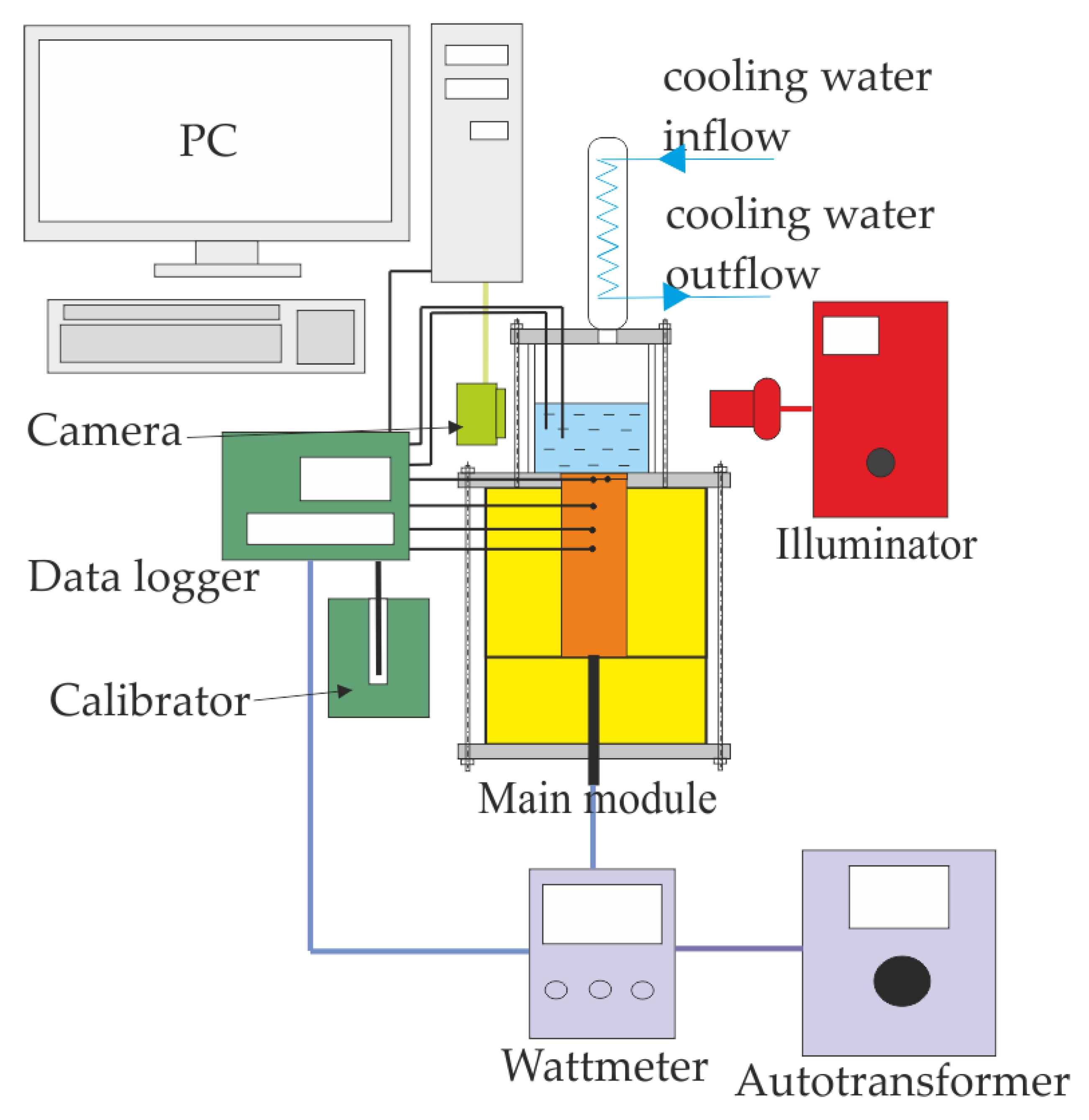
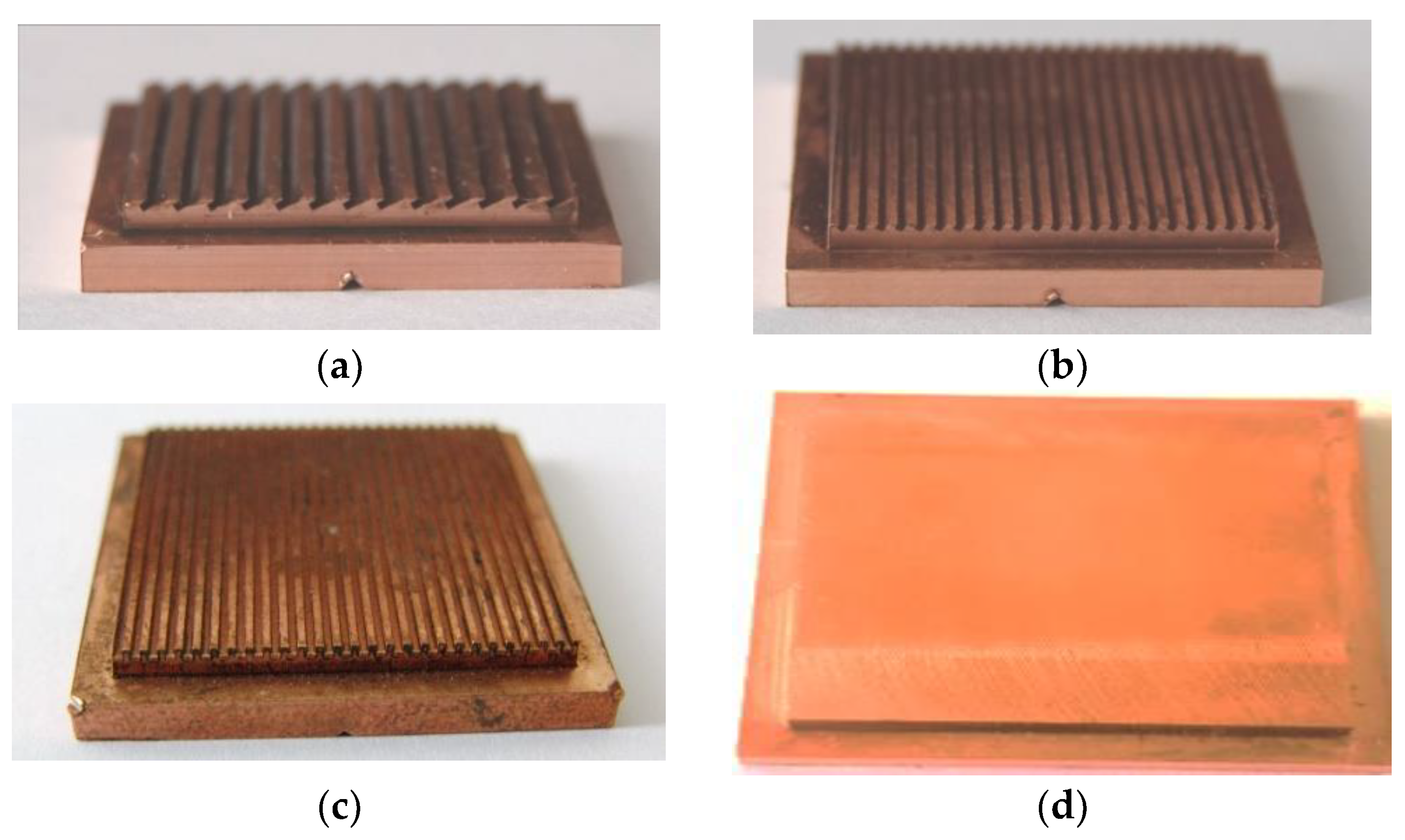





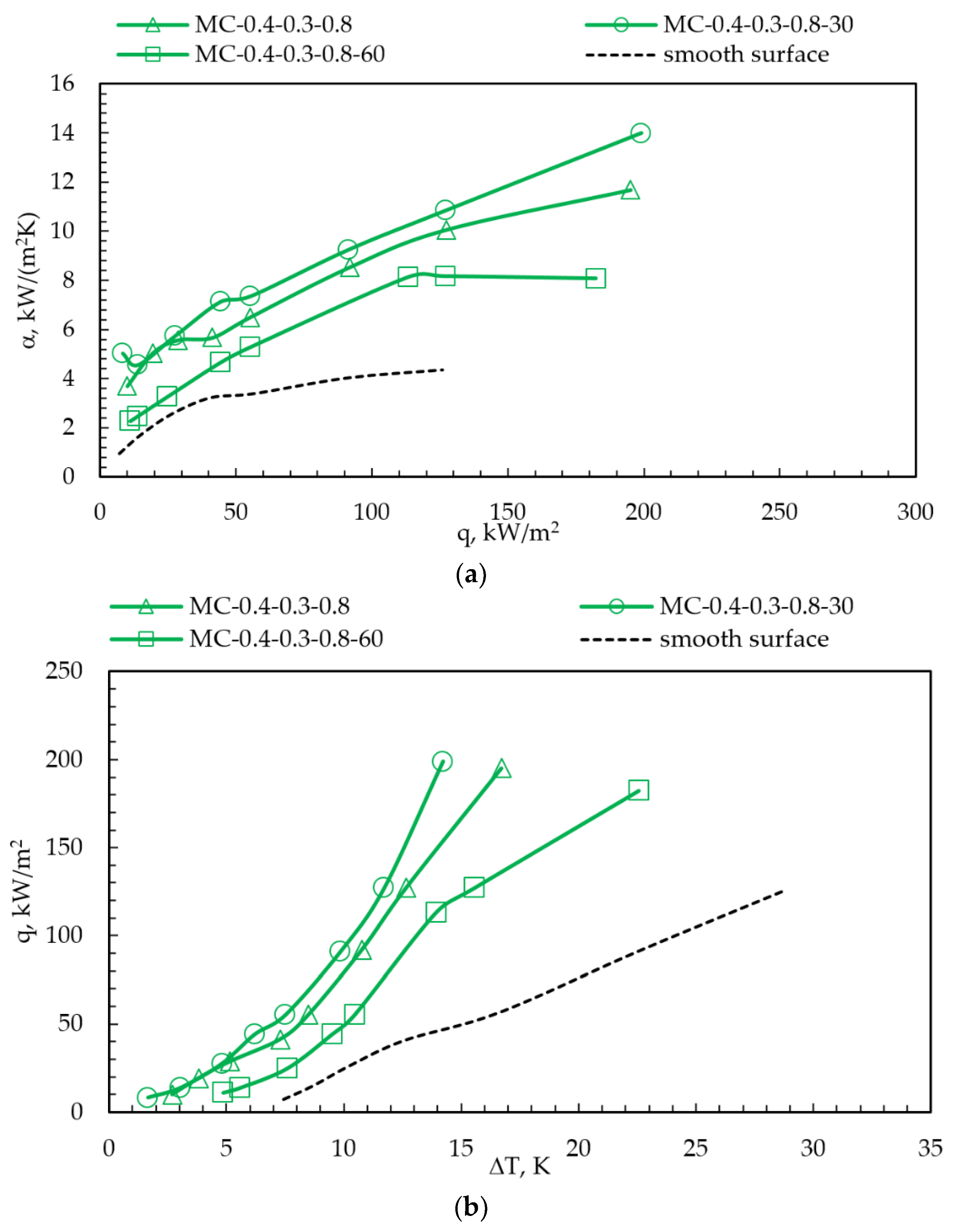
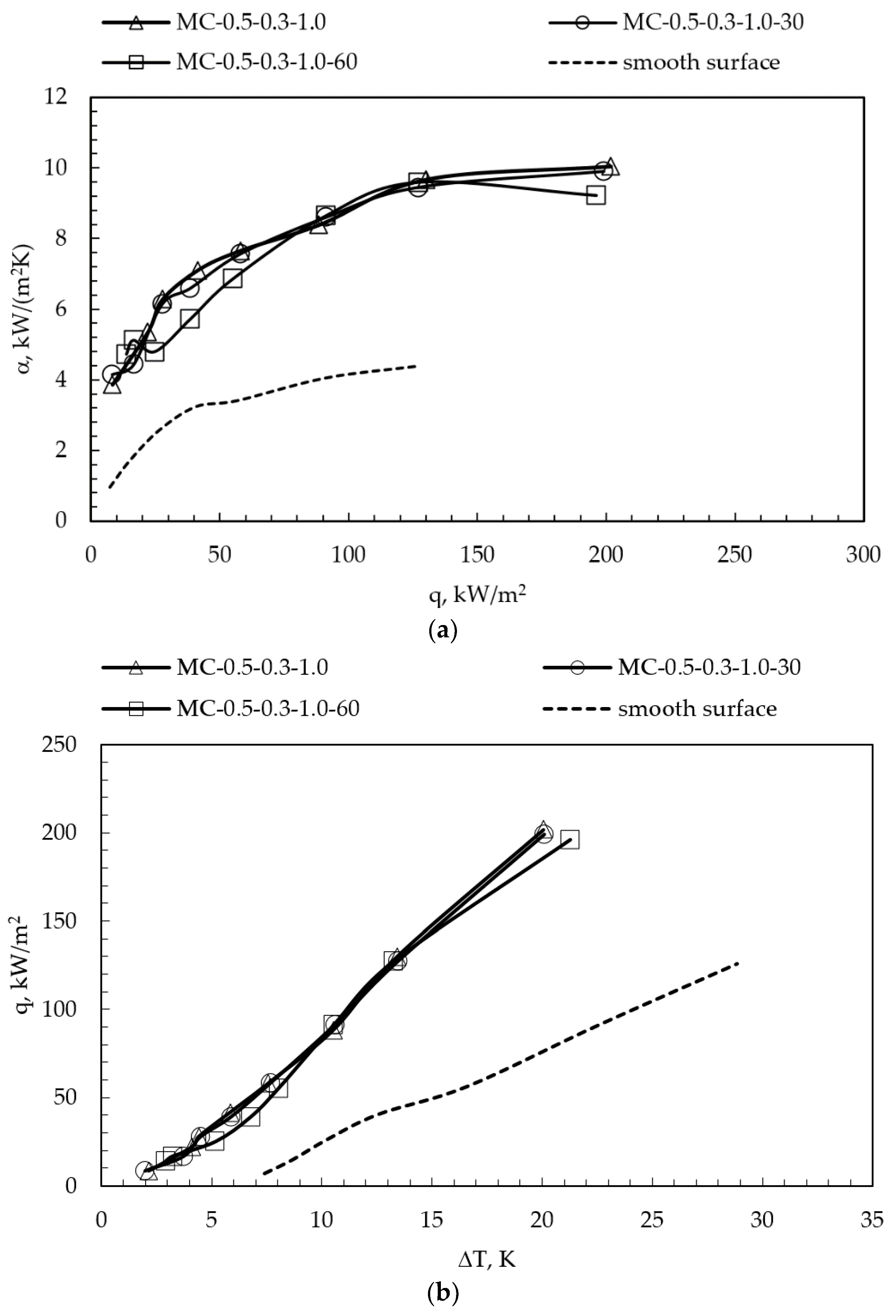
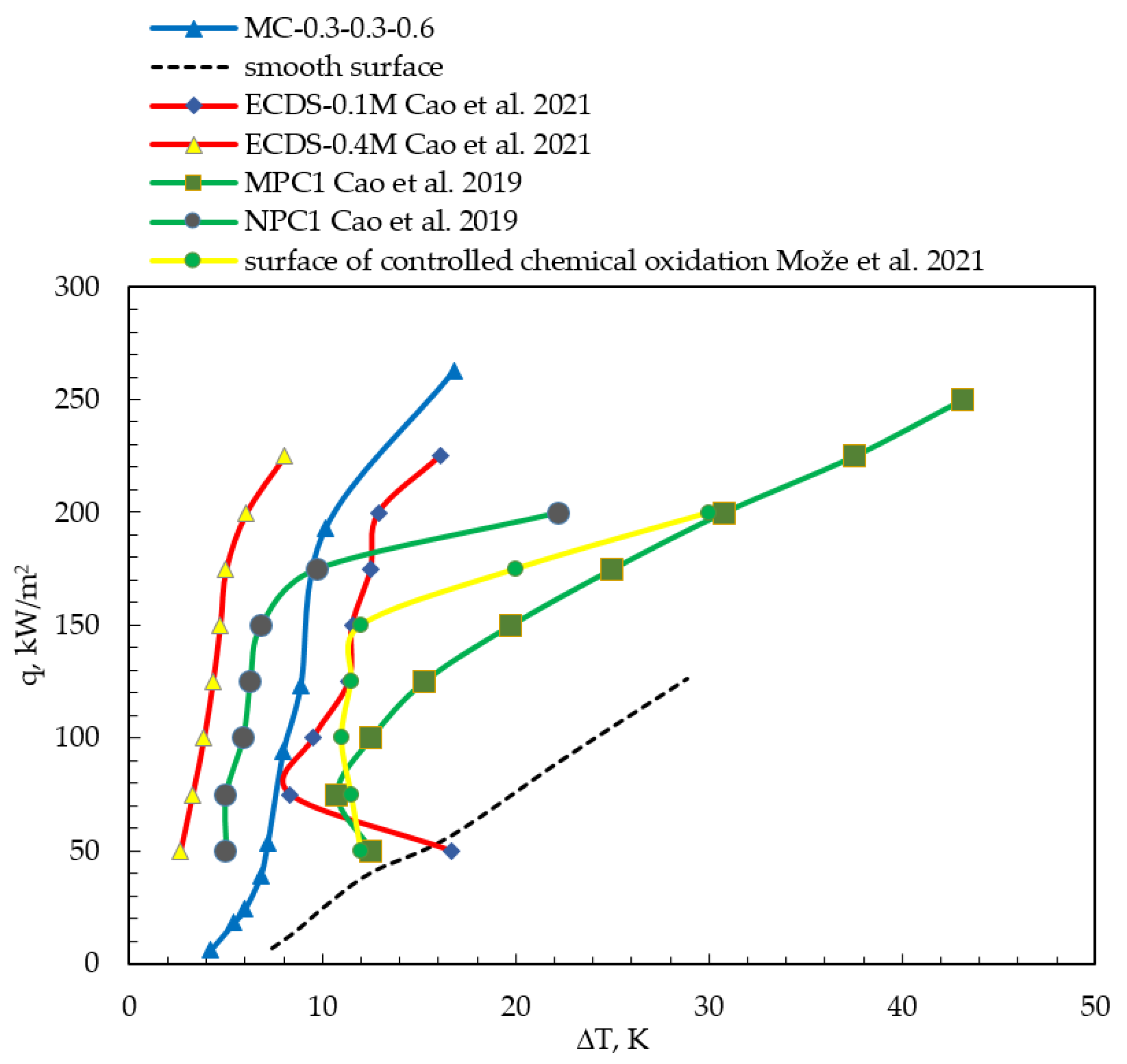

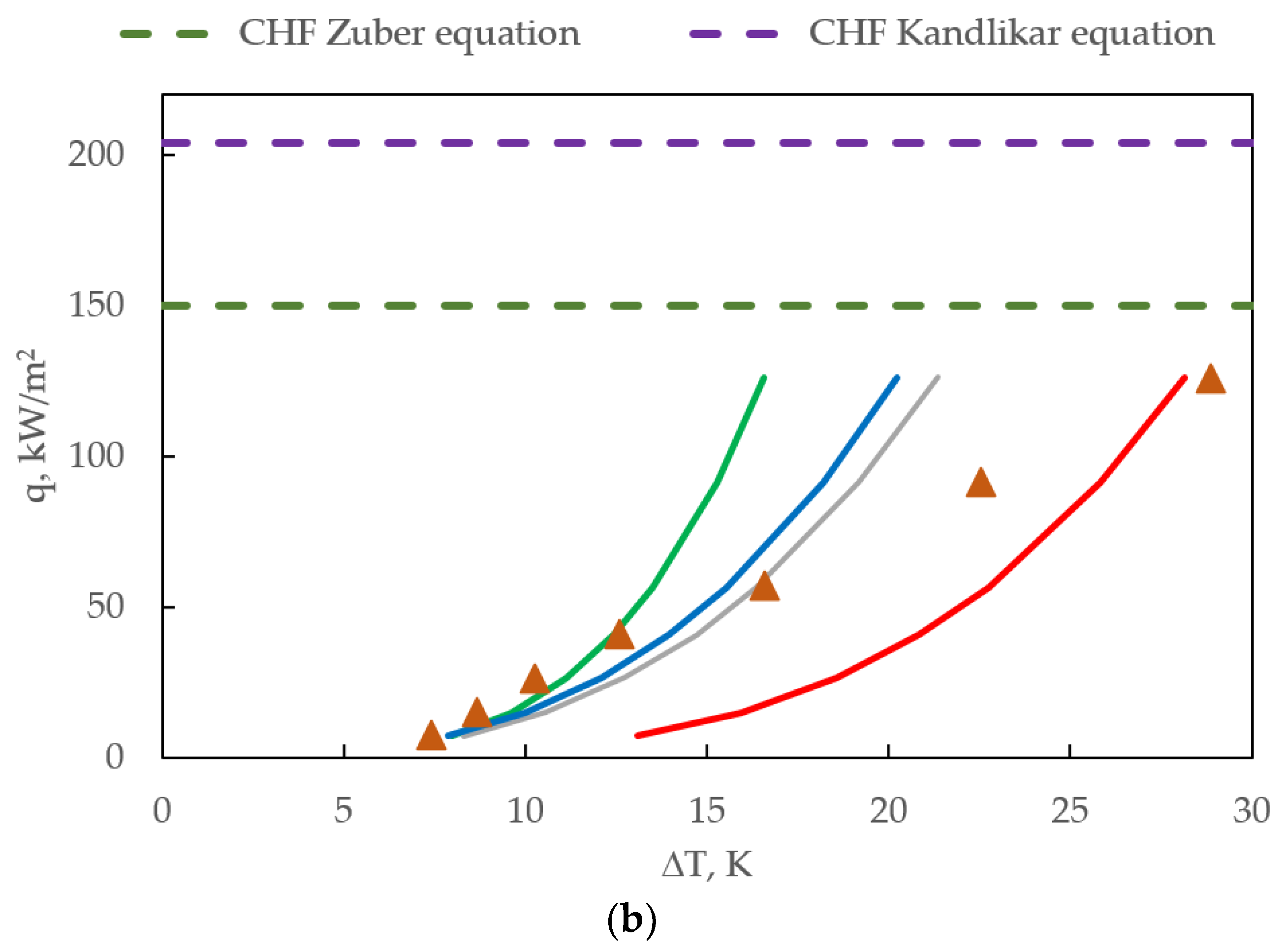
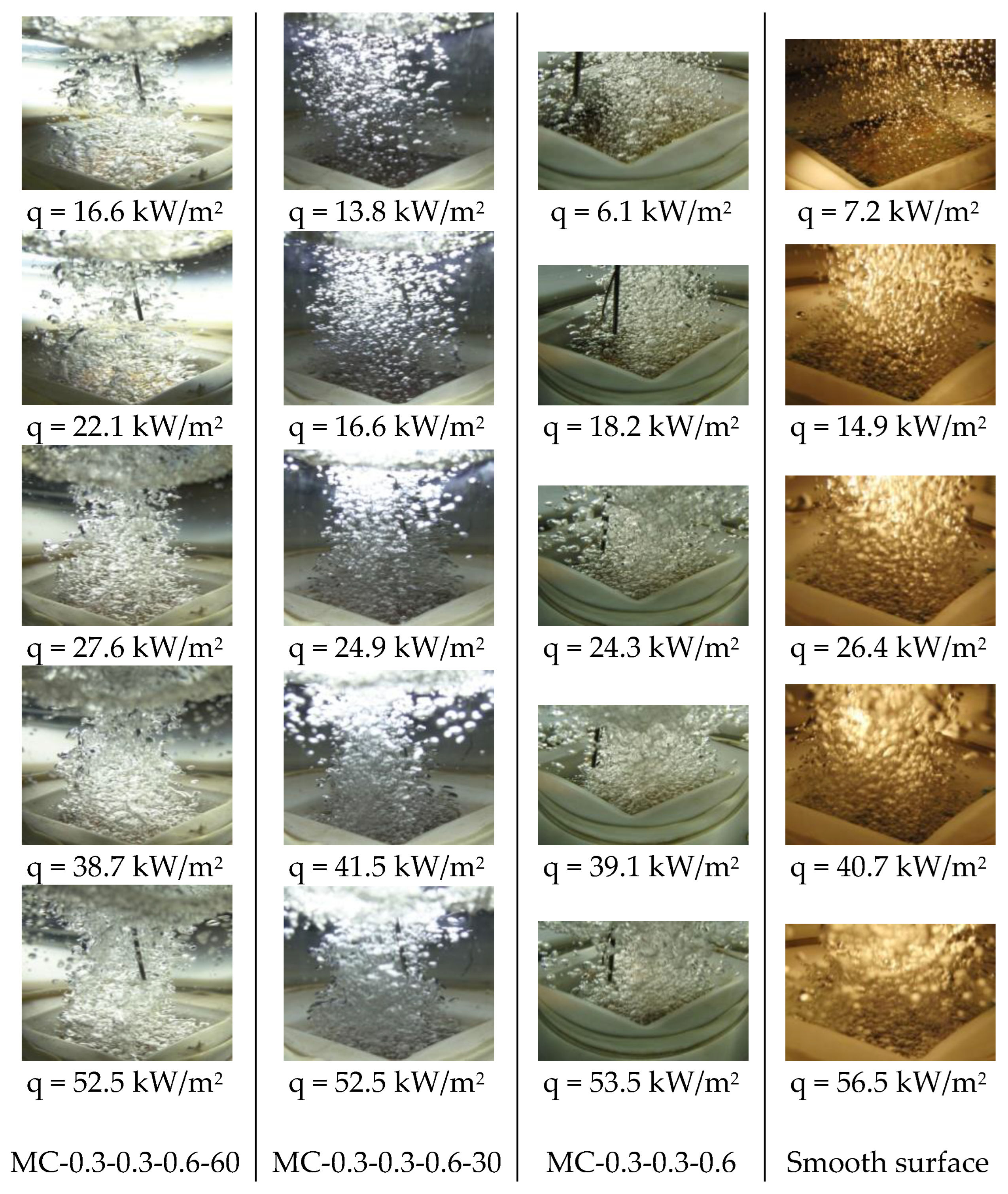
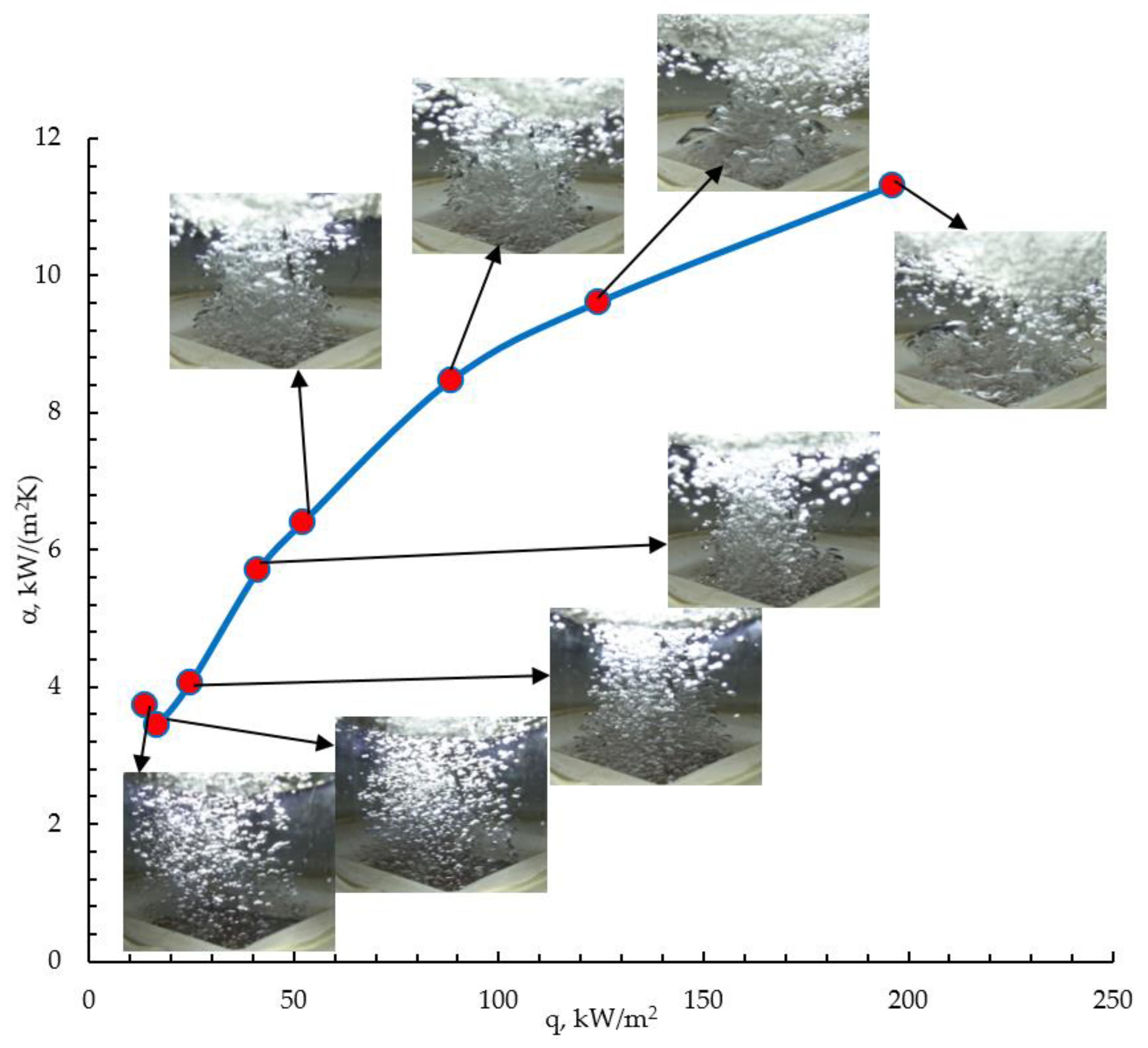
| Specimen Code | w, mm | h, mm | p, mm | b, ° |
|---|---|---|---|---|
| MC-0.2-0.3-0.4 | 0.20 | 0.30 | 0.40 | 0 |
| MC-0.2-0.3-0.4-30 | 0.20 | 0.30 | 0.40 | 30 |
| MC-0.2-0.3-0.4-60 | 0.20 | 0.30 | 0.40 | 60 |
| MC-0.3-0.3-0.6 | 0.30 | 0.30 | 0.60 | 0 |
| MC-0.3-0.3-0.6-30 | 0.30 | 0.30 | 0.60 | 30 |
| MC-0.3-0.3-0.6-60 | 0.30 | 0.30 | 0.60 | 60 |
| MC-0.4-0.3-0.8 | 0.40 | 0.30 | 0.80 | 0 |
| MC-0.4-0.3-0.8-30 | 0.40 | 0.30 | 0.80 | 30 |
| MC-0.4-0.3-0.8-60 | 0.40 | 0.30 | 0.80 | 60 |
| MC-0.5-0.3-1.0 | 0.50 | 0.30 | 1.0 | 0 |
| MC-0.5-0.3-1.0-30 | 0.50 | 0.30 | 1.0 | 30 |
| MC-0.5-0.3-1.0-60 | 0.50 | 0.30 | 1.0 | 60 |
| Smooth surface | - | - | - | - |
| Parameters at 1013.25 hPa | Novec–649 |
|---|---|
| Tsat, K | 322.15 |
| ρl, kgm-3 | 1513 |
| ρv, kgm-3 | 13.42 |
| ilv, Jkg-1 | 88,000 |
| λl, Wm-1K-1 | 0.059 |
| σl, Nm-1 | 0.0108 |
| υl, m2s-1 | 0.0000003 |
| μl, Pas | 0.000454 |
| cpl, Jkg-1K-1 | 1103 |
| pc, kPa | 1880 |
| M, gmol-1 | 316 |
Disclaimer/Publisher’s Note: The statements, opinions and data contained in all publications are solely those of the individual author(s) and contributor(s) and not of MDPI and/or the editor(s). MDPI and/or the editor(s) disclaim responsibility for any injury to people or property resulting from any ideas, methods, instructions or products referred to in the content. |
© 2023 by the author. Licensee MDPI, Basel, Switzerland. This article is an open access article distributed under the terms and conditions of the Creative Commons Attribution (CC BY) license (https://creativecommons.org/licenses/by/4.0/).
Share and Cite
Kaniowski, R. Pool Boiling of Novec-649 on Inclined Microchannel. Energies 2023, 16, 2476. https://doi.org/10.3390/en16052476
Kaniowski R. Pool Boiling of Novec-649 on Inclined Microchannel. Energies. 2023; 16(5):2476. https://doi.org/10.3390/en16052476
Chicago/Turabian StyleKaniowski, Robert. 2023. "Pool Boiling of Novec-649 on Inclined Microchannel" Energies 16, no. 5: 2476. https://doi.org/10.3390/en16052476





